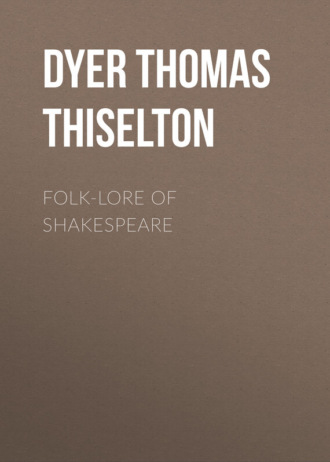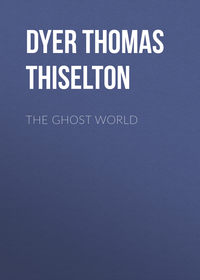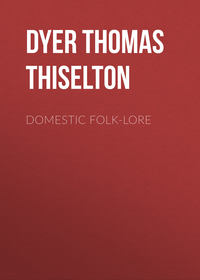 полная версия
полная версияFolk-lore of Shakespeare
“Havoc!” To cry “havoc” appears to have been a signal for indiscriminate slaughter. The expression occurs in “King John” (ii. 1): “Cry havoc, kings!” In “Coriolanus” Menenius says (iii. 1):
“Do not cry havoc, where you should but huntWith modest warrant.”And in “Julius Cæsar” (iii. 1):
“Cry ‘Havoc!’ and let slip the dogs of war.”“Kill, kill, kill, kill, kill him!” This was the ancient cry of the English troops when they charged the enemy. It occurs where the conspirators kill Coriolanus (v. 6).
Leet-Ale. This was the dinner provided for the jury and customary tenants at the court-leet of a manor, or “view of frank-pledge,” formerly held once or twice a year, before the steward of the leet.990 To this court Shakespeare alludes in the “Taming of the Shrew” (i. 2), where the servant tells Sly that in his dream he would “rail upon the hostess of the house,” and threaten to “present her at the leet.”
Aubrey, in his MS. History of Wiltshire, 1678, tells us, too, how “in the Easter holidays was the Clerk’s ale for his private benefit, and the solace of the neighbourhood.”
1
“Illustrations of the Fairy Mythology of ‘A Midsummer-Night’s Dream,’” 1845, p. xiii.
2
“Fairy Mythology,” p. 325.
3
Aldis Wright’s “Midsummer-Night’s Dream,” 1877, Preface, pp. xv., xvi.; Ritson’s “Fairy Mythology,” 1875, pp. 22, 23.
4
Essay on Fairies in “Fairy Mythology of Shakspeare,” p. 23.
5
“Fairy Mythology,” 1878, p. 325.
6
Notes to “A Midsummer-Night’s Dream,” by Aldis Wright, 1877, Preface, p. xvi.
7
“Three Notelets on Shakespeare,” pp. 100-107.
8
See Croker’s “Fairy Legends of South of Ireland,” 1862, p. 135.
9
“Fairy Mythology,” 1878, p. 316.
10
Wirt Sikes’s “British Goblins,” 1880, p. 20.
11
This is reprinted in Hazlitt’s “Fairy Tales, Legends, and Romances, illustrating Shakespeare and other English Writers,” 1875, p. 173.
12
“Illustrations of the Fairy Mythology of the Midsummer-Night’s Dream,” printed for the Shakespeare Society, p. viii.
13
See Brand’s “Pop. Antiq.,” 1849, vol. ii. pp. 508-512.
14
Thoms’s “Three Notelets on Shakespeare,” p. 88.
15
See Nares’s Glossary, vol. ii. p. 695.
16
Mr. Dyce considers that Lob is descriptive of the contrast between Puck’s square figure and the airy shapes of the other fairies.
17
“Deutsche Mythologie,” p. 492.
18
See Keightley’s “Fairy Mythology,” pp. 318, 319.
19
“Three Notelets on Shakespeare,” pp. 79-82.
20
Showing, as Mr. Ritson says, that they never ate.
21
“Letters on Demonology and Witchcraft,” 1831, p. 121.
22
“Illustrations of Shakespeare,” p. 115.
23
“Elizabethan Demonology,” p. 50.
24
Agate was used metaphorically for a very diminutive person, in allusion to the small figures cut in agate for rings. In “2 Henry IV.” (i. 2), Falstaff says: “I was never manned with an agate till now; but I will inset you neither in gold nor silver, but in vile apparel, and send you back again to your master, for a jewel.” In “Much Ado About Nothing” (iii. 1) Hero speaks of a man as being “low, an agate very vilely cut.”
25
See Grimm’s “Deutsche Mythologie.”
26
Thoms’s “Three Notelets on Shakespeare,” 1865, pp. 38, 39.
27
See Keightley’s “Fairy Mythology,” 1878, p. 208.
28
See also Thorpe’s “Northern Mythology,” 1852, vol. iii. p. 32, etc.
81
See Owl, chap. vi.
29
Gunyon’s “Illustrations of Scottish History, Life, and Superstitions,” p. 299.
30
Chambers’s “Book of Days,” vol. i. p. 671.
31
Among the various conjectures as to the cause of these verdant circles, some have ascribed them to lightning; others maintained that they are occasioned by ants. See Miss Baker’s “Northamptonshire Glossary,” vol. i. p. 218; Brand’s “Pop. Antiq.,” 1849, vol. ii. pp. 480-483; and also the “Phytologist,” 1862, pp. 236-238.
32
Douce’s “Illustrations of Shakespeare,” p. 112.
33
Ritson’s “Fairy Mythology,” 1878, pp. 26, 27.
34
Quoted by Brand, “Pop. Antiq.,” vol. ii. p. 481.
35
Brand’s “Pop. Antiq.,” 1849, vol. ii. p. 483.
36
Halliwell-Phillipps’s “Illustrations of Fairy Mythology,” p. 167; see Douce’s “Illustrations of Shakespeare,” pp. 122, 123.
37
“Illustrations of Shakespeare,” pp. 126, 127.
38
See Croker’s “Fairy Legends and Traditions of the South of Ireland,” p. 316.
39
See Brand’s “Pop. Antiq.,” vol. ii. p. 493.
40
Ritson’s “Fairy Mythology of Shakespeare,” 1875, p. 29.
41
Some copies read them.
42
“Fairy Mythology,” pp. 27, 28.
43
We may compare Banquo’s words in “Macbeth” (ii. 1):
“Restrain in me the cursed thoughts that nature Gives way to in repose.”
44
“Comedy of Errors” (iv. 2) some critics read:
“A fiend, a fairy, pitiless and rough.”
45
This superstition is fully described in chapter on Birth.
46
“Superstitions of Witchcraft,” 1865, p. 220.
47
“Shakspere Primer,” 1877, p. 63.
48
“Rationalism in Europe,” 1870, vol. i. p. 106.
49
“Demonology and Witchcraft,” 1881, pp. 192, 193.
50
“Shakespeare,” 1864, vol ii. p. 161.
51
See Dyce’s “Glossary,” p. 51.
52
Webster’s Works, edited by Dyce, 1857, p. 238.
53
“Illustrations of Scottish History, Life, and Superstition,” 1879, p. 322.
54
Spalding’s “Elizabethan Demonology,” 1880, p. 86.
55
“Notes to Macbeth” (Clark and Wright), 1877, p. 137.
56
Scot’s “Discovery of Witchcraft,” 1584, book iii. chap. 16. See Douce’s “Illustrations of Shakespeare,” p. 235.
57
“Elizabethan Demonology,” pp. 102, 103. See Conway’s “Demonology and Devil-lore,” vol. ii. p. 253.
58
“Pop. Antiq.,” 1849, vol. iii. p. 8.
59
Graymalkin – a gray cat.
60
Henderson’s “Folk-Lore of Northern Counties,” p. 181.
61
Olaus Magnus’s “History of the Goths,” 1638, p. 47. See note to “The Pirate.”
62
See Hardwick’s “Traditions and Folk-Lore,” pp. 108, 109; Kelly’s “Indo-European Folk-Lore,” pp. 214, 215.
63
In Greek, ἑπι ῥιπους πλειν, “to go to sea in a sieve,” was a proverbial expression for an enterprise of extreme hazard or impossible of achievement. – Clark and Wright’s “Notes to Macbeth,” 1877, p. 82.
64
“Discovery of Witchcraft,” 1584, book iii. chap. i. p. 40; see Spalding’s “Elizabethan Demonology,” p. 103.
65
See Brand’s “Pop. Antiq.,” vol. iii. pp. 8-10.
66
Douce, “Illustrations of Shakespeare,” p. 245, says: “See Adlington’s Translation (1596, p. 49), a book certainly used by Shakespeare on other occasions.”
67
See Henderson’s “Folk-Lore of the Northern Counties,” 1879, p. 181.
68
See Pig, chap. vi.
69
“Notes to Macbeth,” by Clark and Wright, 1877, p. 84.
70
See Jones’s “Credulities, Past and Present,” 1880, pp. 256-289.
71
Allusions to this superstition occur in “Love’s Labour’s Lost” (i. 2), “love is a familiar;” in “1 Henry VI.” (iii. 2), “I think her old familiar is asleep;” and in “2 Henry VI.” (iv. 7), “he has a familiar under his tongue.”
72
See Scot’s “Discovery of Witchcraft,” 1584, p. 85.
73
Sec Dyce’s “Glossary,” pp. 18, 19.
74
“Notes to Macbeth” (Clark and Wright), pp. 81, 82.
75
We may compare the words “unquestionable spirit” in “As You Like It” (iii. 2), which means “a spirit averse to conversation.”
76
Douce’s “Illustrations of Shakespeare,” pp. 450, 451.
77
Vast, i. e., space of night. So in “Hamlet” (i. 2):
“In the dead waste and middle of the night.”
78
See p. 104.
79
See Hardwick’s “Traditions, Superstitions, and Folk-lore,” 1872, pp. 153-176.
80
“Shakespeare and His Times,” vol. i. p. 378.
81
“Elizabethan Demonology,” p. 49.
82
Harsnet’s “Declaration of Egregious Popish Impostures,” p. 225.
83
“Pop. Antiq.,” 1849, vol. ii. pp. 517-519.
84
Ibid. vol. i. pp. 365-367.
85
See Jones’s “Credulities, Past and Present,” 1880, p. 133.
86
See Scot’s “Discovery of Witchcraft,” 1584, p. 393; Douce’s “Illustrations of Shakespeare,” p. 264.
87
Ibid. p. 378.
88
Singer’s “Shakespeare,” vol. x. p. 292.
89
“Illustrations of Shakespeare,” 1839, pp. 255, 256.
90
Singer’s “Shakespeare,” vol. viii. p. 208.
91
See Knight’s “Life of Shakespeare,” 1843, p. 63.
92
“Pop. Antiq.,” 1849, vol. iii. p. 241.
93
See Swainson’s “Weather-Lore,” 1873, p. 176, for popular adages on the Continent.
94
“Weather-Lore,” pp. 175, 176.
95
Napier’s “Folk-Lore of West of Scotland,” 1879, p. 141.
96
Quoted in Southey’s “Commonplace Book,” 1849, 2d series, p. 462.
97
See Tylor’s “Primitive Culture,” 1871, vol. i. pp. 261, 296, 297, 321.
98
In “3 Henry VI.” (ii. 1), Edward says:
“henceforward will I bear
Upon my target three fair shining suns.”
99
“Glossary to Shakespeare,” p. 283.
100
Ray gives the Latin equivalent “Ab equis ad asinos.”
101
Baring-Gould’s “Curious Myths of the Middle Ages,” 1877, p. 190.
102
Cf. “Love’s Labour’s Lost” (v. 2): “Yet still she is the moon, and I the man.”
103
Fiske, “Myths and Mythmakers,” 1873, p. 27.
104
“Curious Myths of the Middle Ages,” 1877, p. 197.
105
Douce’s “Illustrations of Shakespeare,” 1839, p. 10.
106
For further information on this subject, see Tylor’s “Primitive Culture,” 1873, vol. i. pp. 288, 354-356; vol. ii. pp. 70, 202, 203.
107
See Brand’s “Pop. Antiq.,” vol. iii. pp. 142, 143.
108
See “English Folk-lore,” pp. 43, 44.
109
“Primitive Culture,” 1873, vol. i. pp. 354, 355.
110
The words “moonish” (“As You Like It,” iii. 2) and “moonlike” (“Love’s Labour’s Lost,” iv. 3) are used in the sense of inconstant.
111
See Douce’s “Illustrations of Shakespeare,” 1839, p. 18.
112
Tylor’s “Primitive Culture,” vol. i. p. 329.
113
“Illustrations of Shakespeare,” 1839, p. 16.
114
See Scot’s “Discovery of Witchcraft,” 1584, pp. 174, 226, 227, 250.
115
For further examples, see Douce’s “Illustrations of Shakespeare,” p. 17.
116
See Douce’s “Illustrations of Shakespeare,” 1839, p. 116.
117
See Swainson’s “Weather-Lore,” 1873, pp. 182-192.
118
See Tylor’s “Primitive Culture,” 1873, vol. i. p. 130; “English Folk-Lore,” 1878, pp. 41, 42.
119
See Swainson’s “Weather-Lore,” pp. 182, 183.
120
See Williams’s “Superstitions of Witchcraft,” pp. 123-125; Scot’s “Discovery of Witchcraft,” bk. iv. p. 145.
121
“Illustrations of Shakespeare,” 1839, p. 405.
122
Nares’s “Glossary,” 1872, vol. ii. p. 580.
123
“Primitive Culture,” vol. i. p. 131.
124
Cf. “Richard III.” (iv. 4); “1 Henry IV.” (i. 1, iii. 1); “Antony and Cleopatra” (iii. 13); “The Tempest” (i. 2); “Hamlet” (i. 4); “Cymbeline” (v. 4); “Winter’s Tale” (iii. 2); “Richard II.” (iv. 1).
125
“Primitive Culture,” vol. i. p. 131; see Brand’s “Popular Antiquities,” 1849, vol. iii. pp. 341-348.
126
“Walton’s Lives,” 1796, p. 113, note.
127
Douce’s “Illustrations of Shakespeare,” 1839, p. 397.
128
Ibid. p. 3.
129
See Brand’s “Pop. Antiq.,” 1849, vol. iii. p. 400.
130
Purchas, “His Pilgrimes” (1625, pt. i. lib. iii. p. 133), quoted by Mr. Aldis Wright in his “Notes to The Tempest,” 1875, p. 86.
131
See Puck as Will-o’-the-Wisp; chapter on “Fairy-Lore.”
132
See “Notes and Queries,” 5th series, vol. x. p. 499; Brand’s “Pop. Antiq.,” 1849, vol. iii. p. 410; Nares’s “Glossary,” vol. i. p. 309.
133
A “fire-drake” appears to have been also an artificial firework, perhaps what is now called a serpent. Thus, in Middleton’s “Your Five Gallants” (1607):
“But, like fire-drakes, Mounted a little, gave a crack and fell.”
134
“New Illustrations of the Life, Studies, and Writings of Shakespeare,” vol. ii. p. 272.
135
See Thoms’s “Notelets on Shakespeare,” p. 59.
136
“Fairy Mythology,” edited by Hazlitt, 1875, p. 40.
137
Among the many other names given to this appearance may be mentioned the following: “Will-a-wisp,” “Joan-in-the-wad,” “Jacket-a-wad,” “Peg-a-lantern,” “Elf-fire,” etc. A correspondent of “Notes and Queries” (5th series, vol. x. p. 499) says: “The wandering meteor of the moss or fell appears to have been personified as Jack, Gill, Joan, Will, or Robin, indifferently, according as the supposed spirit of the lamp seemed to the particular rustic mind to be a male or female apparition.” In Worcestershire it is called “Hob-and-his-lanthorn,” and “Hobany’s” or “Hobnedy’s Lanthorn.”
138
Mr. Ritson says that Milton “is frequently content to pilfer a happy expression from Shakespeare – on this occasion, ‘night-wanderer.’” He elsewhere calls it “the friar’s lantern.”
139
Thorpe, “Northern Mythology,” 1852, vol. iii. pp. 85, 158, 220.
140
“Notelets on Shakespeare,” pp. 64, 65.
141
Ibid.
142
See Proctor’s “Myths of Astronomy;” Chambers’s “Domestic Annals of Scotland,” 1858, vol. ii. pp. 410-412; Douce’s “Illustrations of Shakespeare,” pp. 364, 365.
143
See Patterson’s “Insects Mentioned by Shakespeare,” 1841, p. 145.
144
“Letters,” vol. i. p. 310; vol. vi. pp. 1, 187. – Ed. Cunningham.
145
Douce’s “Illustrations of Shakespeare,” 1839, p. 369.
146
See Tylor’s “Primitive Culture,” vol. i. pp. 364-367.
147
See Swainson’s “Weather-Lore.”
148
Batman upon Bartholomæus – “De Proprietatibus Rerum,” lib. xi. c. 3.
149
Polwhele’s “Cornish Vocabulary.”
150
Cf. “Macbeth,” iii. 4, “O, these flaws and starts.”
151
See Harland and Wilkinson’s “Lancashire Folk-Lore,” 1867, pp. 116-121; “Notes and Queries,” 1st series, vol. viii. p. 224; “Penny Cyclopædia,” vol. vii. p. 206, article “Cirripeda.”
152
Nares’s “Glossary,” 1872, vol. i. p. 56.
153
See Harting’s “Ornithology of Shakespeare,” 1871, pp. 246-257.
154
“Ornithology of Shakespeare,” 1871, p. 252.
155
See “Philosophical Transactions” for 1835; Darwin’s “Monograph of the Cirrhipedia,” published by the Ray Society; a paper by Sir J. Emerson Tennent in “Notes and Queries,” 1st series, vol. viii. p. 223; Brand’s “Popular Antiquities,” 1849, vol. iii. pp. 361, 362; Douce’s “Illustrations of Shakespeare,” 1839, p. 14.
156
See Yarrell’s “History of British Birds,” 2d edition, vol. i. p. 218; “Dialect of Leeds,” 1862, p. 329. In “Hamlet” (iii. 2), some modern editions read “ouzle;” the old editions all have weasel, which is now adopted.
157
Miss Baker’s “Northamptonshire Glossary,” 1854, vol. i. p. 94. See Nares’s “Glossary,” 1872, vol. i. p. 124; and “Richard III.,” i. 1.
158
Harting’s “Ornithology of Shakespeare,” p. 144; Halliwell-Phillipps’s “Handbook Index to Shakespeare,” 1866, p. 187. The term finch, also, according to some, may mean either the bullfinch or goldfinch.
159
See Yarrell’s “History of British Birds,” 2d edition, vol. ii. p. 58.
160
Nares’s “Glossary,” vol. i. p. 156; Singer’s “Shakespeare,” 1875, vol. v. p. 115; Dyce’s “Glossary,” 1876, p. 77.
161
Mr. Dyce says that if Dr. Latham had been acquainted with the article “Chouette,” in Cotgrave, he would not probably have suggested that Shakespeare meant here the lapwing or pewit. Some consider the magpie is meant. See Halliwell-Phillipps’s “Handbook Index to Shakespeare,” 1866, p. 83. Professor Newton would read “russet-patted,” or “red-legged,” thinking that Shakespeare meant the chough.
162
“Glossary,” vol. i. p. 162; Singer’s “Notes to Shakespeare,” 1875, vol. v. p. 42.
163
Massinger’s Works, 1813, vol. i. p. 281.
164
“Handbook Index to Shakespeare,” 1866, p. 86.
165
Miss Baker’s “Northamptonshire Glossary,” 1854, vol. i. p. 116.
166
“Coriolanus,” iv. 5; “Troilus and Cressida,” i. 2; “Much Ado About Nothing,” ii. 3; “Twelfth Night,” iii. 4; “Love’s Labour’s Lost,” v. 2, song; “1 Henry VI.” ii. 4.
167
Swainson’s “Weather-Lore,” 1873, p. 240.
168
Henderson’s “Folk-Lore of Northern Counties,” 1879, p. 48.
169
See Douce’s “Illustrations of Shakespeare,” p. 438.
170
See Ibid.
171
See Brand’s “Pop. Antiq.,” 1849, vol. ii. pp. 51-57; Hampson’s “Medii Œvi Kalendarium,” vol. i. p. 84.
172
1st series, vol. iii. p. 404.
173
“Medii Œvi Kalendarium,” vol. i. p. 85.
174
Roberts’s “Social History of Southern Counties of England,” 1856, p. 421; see “British Popular Customs,” 1876, p. 65.
175
Nares’s “Glossary,” 1872, vol. i. p. 203.
176
Singer’s “Shakespeare,” 1875, vol. ix. p. 256; Halliwell-Phillipps’s “Handbook Index to Shakespeare,” p. 112.
177
Dyce’s “Glossary to Shakespeare,” p. 85.
178
“Illustrations of Shakespeare,” 1839, p. 290.
179
“Ornithology of Shakespeare,” p. 171.
180
It is also an ale-house sign.
181
See Dyce’s “Glossary to Shakespeare,” p. 85.
182
See “Book of Days,” 1863, vol. i. p. 157.
183
In “King Lear” (iv. 6), where Edgar says:
“Yond tall anchoring bark,
Diminish’d to her cock; her cock, a buoy
Almost too small for sight.”
the word “cock” is an abbreviation for cock-boat.
184
For superstitions associated with this bird, see Brand’s “Pop. Antiq.,” 1849, vol. iii. p. 218.
185
“Ornithology of Shakespeare,” p. 260.
186
See “Folk-Lore Record,” 1879, vol. i. p. 52; Henderson’s “Folk-Lore of Northern Counties,” 1879, pp. 25, 126, 277.
187
Nares’s “Glossary,” vol. i. p. 208.
188
Cf. “Henry IV.,” iv. 2.
189
Miss Baker’s “Northamptonshire Glossary,” vol. ii. p. 161; Brand’s “Pop. Antiq.,” 1849, vol. iii. p. 393.
190
Cf. “Romeo and Juliet,” i. 5.
191
“A cuckold being called from the cuckoo, the note of that bird was supposed to prognosticate that destiny.” – Nares’s “Glossary,” vol. i. p. 212.
192
Engel’s “Musical Myths and Facts,” 1876, vol. i. p. 9.
193
See Kelly’s “Indo-European Folk-Lore,” 1863, p. 99; “English Folk-Lore,” 1879, pp. 55-62.
194
See Mary Howitt’s “Pictorial Calendar of the Seasons,” p. 155; Knight’s “Pictorial Shakespeare,” vol. i. pp. 225, 226.
195
Chambers’s “Book of Days,” vol. i. p. 531.
196
See Brand’s “Pop. Antiq.,” 1849, vol. ii. p. 201.
197



